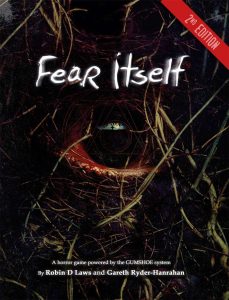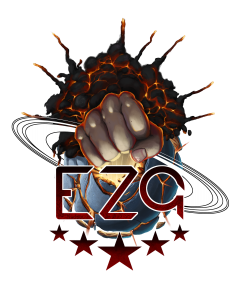Fear Itself 2nd Edition (GUMSHOE)
Fear Itself 2nd Edition (GUMSHOE)

The second edition of the Fear Itself horror game clocks in at 178 pages, 1 page front cover, 1 page inside of front cover, 2 pages of editorial, 2 pages of ToC, leaving us with 173 pages of content. These include a two-page index and a 1-page character sheet.
After a brief introduction, we are introduced to the basics of the game, which is the first huge difference in comparison to the 1st edition. You see, where the first edition was intended for one-shots and as a kind of hack for Esoterrorists or similar GUMSHOE-based games, this edition is actually a full-blown stand-alone game. While this playstyle is still fully supported, the game now differentiates between angles from the get-go: The book notes that one-shot, mini-series and full-blown campaign are all possible, and also lists which sections in the book you should check out. Nice. The game is set in the same dark version of our world as Esoterrorists, meaning that the Outer Dark and its entities represent the primary antagonists. Books that feature this myth are tagged as “Ocean Game”, after the process by which one of the most formidable type of creature likes playing with mortals in a strange game, driving them insane.
Unlike Esoterrorists, this game does not assume that you have a benevolent organization or proper background to have at least sometimes a fighting chance against the Outer Dark – instead, Fear Itself focuses on more action-laden horror and a feeling of powerlessness; it’s less about uncovering full-blown wrongness of the universe, and more about survival, though themes can easily be mixed and matched. In one of my earlier reviews, I proposed kicking off a GUMSHOE-campaign with Fear Itself, and then, after the PCs have been recruited by the OV, using the Esoterrorist or Night’s Black Agents-rules (or a combination thereof!) for the next chapter of the campaign.
Fear Itself does not cast you in the role of heroes – the PCs are everyday people, and as such, there is a difference in focus and power-level that is reflected by the rules, but before we get into the details, let it be known that I do actually own the softcover of the game, as well as the pdf-version. I primarily based my review on the print copy.
Fear Itself deliberately restricts the use of combat/investigative experts and occult experts, which are considered to be out of the question unless this works in conjunction with your premise. Psychics are also restricted in a way – rules for them are provided, but they are risky. Unlike Esoterrorists, there is no OV guideline against these guys, so yeah – that’s a rather different angle. The Fear Itself game assumes the characters to be ordinary folks, and this angle is reflected in character creation: The number of players dictates the suggested number of build points per character, and there are capped abilities that are not available at character creation, unless you’re the group’s expert in the given field. Being an “expert” in a field means that you usually pay for your expert rank by some sort of drawback, which brings us to a crucial narrative angle that enriches the game and that can be rather fun: Risk factors. These represent, for example, a stern conviction in the scientific, a drug addiction, curiosity – all those behaviors that make characters die in horror movies. There are hard and soft risk factors, and resisting them requires a stability test, punishing the character for not giving in, while rewarding “risky” play and providing an incentive to creating tension.
But before we get to stability, let’s talk about abilities: Beyond a limit on aforementioned capped abilities, there are two survival abilities: Fleeing and Hiding. If your Fleeing is equal or higher than Athletics, you get 2 Fleeing for every build point spent, and the same holds true for Infiltration and Hiding. Infiltration and Athletics are universally better than Hiding and Fleeing, hence the discount – and this obviously enhances the emphasis on fleeing/hiding vs. direct combat. Concise lists of the abilities are provided – they are generally grouped in the categories Academic, Interpersonal, Technical, and General.
Stability, briefly noted before, is pretty self-explanatory – it’s the mental stamina and ability to resist sources of stress and mental breakdown. As such, the book guides you through the process of determining the cornerstones of your sources of stability. From neighbors to certain tasks to pets, these sources of stability are what keep you standing, and their development obviously provides means to attack the character; they are a catalyst for roleplaying, for saving them, for getting your character involved. The requirement, hardcoded into the game, ultimately, means that both GM and player have reasons to engage with the NPCs, be proactive in roleplaying.
Indeed, one of the things I very much enjoyed seeing, would be the salient advice provided for players, helping the game immensely. From embracing the flashbacks to roleplaying the mundane, to how to deal with being stuck in investigations, this section is really useful, particularly when dealing with players that are relatively new to GUMSHOE-based games.
A big difference to the previous iteration would be that we actually have the system explained in a concise manner: As you probably know about now, you can Spend points in your abilities to gain additional information – this game of resource management is crucial to how GUMSHOE works, and we have the process explained – and all abilities are noted with sample clues and benefits from the use of the abilities explained. This may sound obvious, it really helps GMing the game, and it makes it easier for players to know which abilities to choose. The ability-list has also been expanded, with new abilities getting a helpful “New”-tag, making conversion of older supplements easier. These new abilities also enhance the game in that they represent options that enhance the ability to play longer campaigns. Health now is just such an ability, changing that aspect.
Mechanically, the game has a simple resolution mechanic: If you have a point in ability, you can roll a six-sided die. The target difficulty numbers range from 2 to 8 (usually), and for each spend, you add +1 to the roll. The players do NOT know the target difficulty of the roll, just fyi. Other characters can piggyback on rolls – paying 1 point from the relevant ability, they can piggyback…but being unable to pay increases the difficulty by 2, which can be rather brutal. Contests follow an analogue mechanic, making that aspect simple to resolve as well. The narrative repercussions and how to handle the like are included.
When you exceed an opponent’s Hit Threshold, you may deal damage, rolling a die and applying modifier. Not having points in combat-relevant abilities locks you into the action you announce at the start of a round, decreases your damage, makes you go last and firearms have a chance of going wrong, big time. So yeah – if you have no combat training, you better be careful.., At 0 Health, you are Hurt; Starting at -6 Health, you are seriously wounded, and at -12 Health, you’re dead. Stability has similar thresholds, with effects like starting to close off, etc., despair, etc. Rules of thumb for different genres of horror are provided for your convenience, and indeed, particularly newer GMs and groups will definitely appreciate the vast array of pieces of advice contained within these pages.
Speaking of which: The GM gets a LOT of helpful advice herein, walking you through the process of designing a mystery, of how to use clues, determine core scenes, personalizing horror, when to use floating clues. A similar amount of guidance is provided not only for the process of designing a mystery, but also for the actual running of the mystery. Alternative rules like escape pools further enhance this section. Low and high-powered psychics, and some minor suggestions on running an all-psychic game may also be found within the pages of this massive book.
A couple of sample creatures that will mostly be familiar to Ocean Game veterans may be found, and the book contains stats for classics like slashers, werewolves, zombies, etc. Then, the book’s structure begins to change – as noted before, the game now has a broader perspective, and as such, features chapters for one-shots, mini-series and campaigns. For the one-shot, we get a sample adventure to accompany the general advice provided – it is a nice one, though the twist may be something the PCs see coming. The mini-series and campaign chapters have outlines provided instead of fully-fleshed out adventures – the latter two imho are more interesting, particularly the mini-series’ hook, but since that is very much a matter of taste, it won’t influence the final verdict.
Conclusion:
Editing and formatting are very good on a formal and rules-language level. Layout adheres to a neat two-column b/w-standard, and the book features quite a bunch of nice b/w-artwork that ranges from inspired to solid. The softcover version has glossy paper, and the pdf comes fully bookmarked for your convenience. Personally, I think that going hardcover for the book would have been nice.
The second edition of Robin D Laws and Gareth Ryder-Hanrahan’s Fear Itself-game is superior to the first in every way; no longer simply a hack to slap onto a GUMSHOE game, capable of being used as a stand-alone supplement, Fear Itself is a versatile investigative horror game that is deadly, interesting and has an amazing world; I am a huge fan of the whole Ocean game mythology, and frankly, I don’t understand why these games don’t get more love from the gaming public, particularly when compared to the Cthulhu-mythos. There is but one aspect of this book where it falls flat of the first edition: In the sample adventure/outline. Fear Itself’s first edition had a BRILLIANT sample adventure, and while the options herein are well-wrought, they don’t manage to attain that same level of pure horror. That being said, this book now presents all the tools you need to actually craft horror mysteries for your group – which you’ll have to do. As per the writing of this review, there only are two modules released for the game’s first edition. I will cover both of them, but yeah – much like the criminally underrated Esoterrorists, this is one of the Pelgrane Press games that’d deserve more love. If you’re looking for a change of pace from the tentacles, give this a shot – chances are, you’ll very much enjoy it! My final verdict will clock in at 4.5 stars, rounded up due to in dubio pro reo.
You can get this horror game here on OBS!
Enjoying my reviews? Please consider supporting me here on patreon!

Endzeitgeist out.
